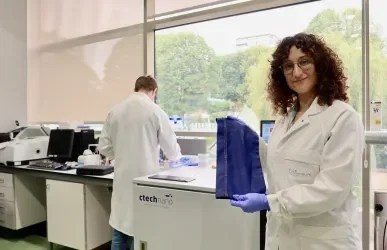Technology developed at CIC nanoGUNE driving forward innovation in the textile industry
The Basque nanoscience research center CIC nanoGUNE is developing specific techniques to functionalize fibers and fabrics in the textile industry. This promising line of research, led by the Nanomaterials group, is part of an Elkartek project in which the Gaiker technology center, which tests the final properties of the treated fabrics, and the textile company Andromeda Moto, which supplies the fabrics, are also participating.

Innovation for the textile industry is not exclusively in design and fashion. The industry and the market are increasingly calling for innovative textiles that are adapted for the use for which they are designed. Over the last few decades, nanotechnology has developed various techniques to modify the properties of materials “à la carte”, which is why it is an indisputable ally in the development of new fibers that provide our garments with new properties, making them tougher, more waterproof, UV protective, antimicrobial, stain repellent, etc.
With this objective in mind, the Nanomaterials group at nanoGUNE is working to develop multifunctional textile fibers. To do this, “we combine two techniques in which we have a great deal of experience: 'atomic layer deposition' and 'vapor phase infiltration' to incorporate nanometric particles of biocompatible materials, such as titanium oxide or zinc oxide, into textile fibers. That way we change the nature of common fabrics, such as cotton, polyester or nylon, and give them new properties”, said researcher Natalia Chamorro.
ALD (Atomic Layer Deposition) is a technique widely used in many industrial sectors to functionalize materials by depositing thin layers of small particles on their surfaces. VPI (Vapor Phase Infiltration) is a technique developed in Germany by the researcher Mato Knez, leader of the Nanomaterials group, and applied at nanoGUNE; thanks to the ongoing evolution of the technique, it is currently being used worldwide to improve materials. “It's a modification of ALD,” explained Chamorro, “which allows the deposited particles not only to coat the material but also to infiltrate its internal structure, causing the chemical and physical properties to change a great deal more”.
Through the project, this technique is being studied and perfected for its potential application in the textile industry. “We have seen a great improvement in the waterproofing of certain fabrics, which have gone from soaking in the rain to repelling water. What is more, the study of certain bacteria has enabled us to provide certain fabrics, such as cotton or denim, with antimicrobial and anti-odor properties. We have also managed to increase protection against ultraviolet rays,” said Natalia Chamorro.
“Another factor to be taken very much into account is the durability and stability of the coating during washing processes,” said the nanoGUNE researcher. “The VPI technology applied at nanoGUNE has yielded very good results, as after several washing cycles we saw that the particles remain well attached to the textile, thus maintaining the new, improved properties they provide the fabric with.”
According to Natalia Chamorro, “the textile industry is facing a major opportunity to create new, improved, nanotechnology-based products that meet the demands of consumers and companies, and many are beginning to invest in innovations of this type to improve people's daily lives”.
